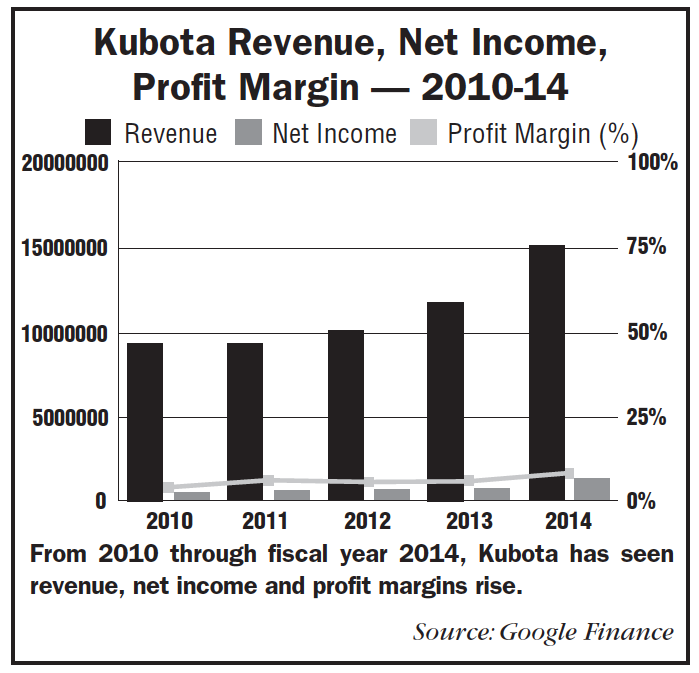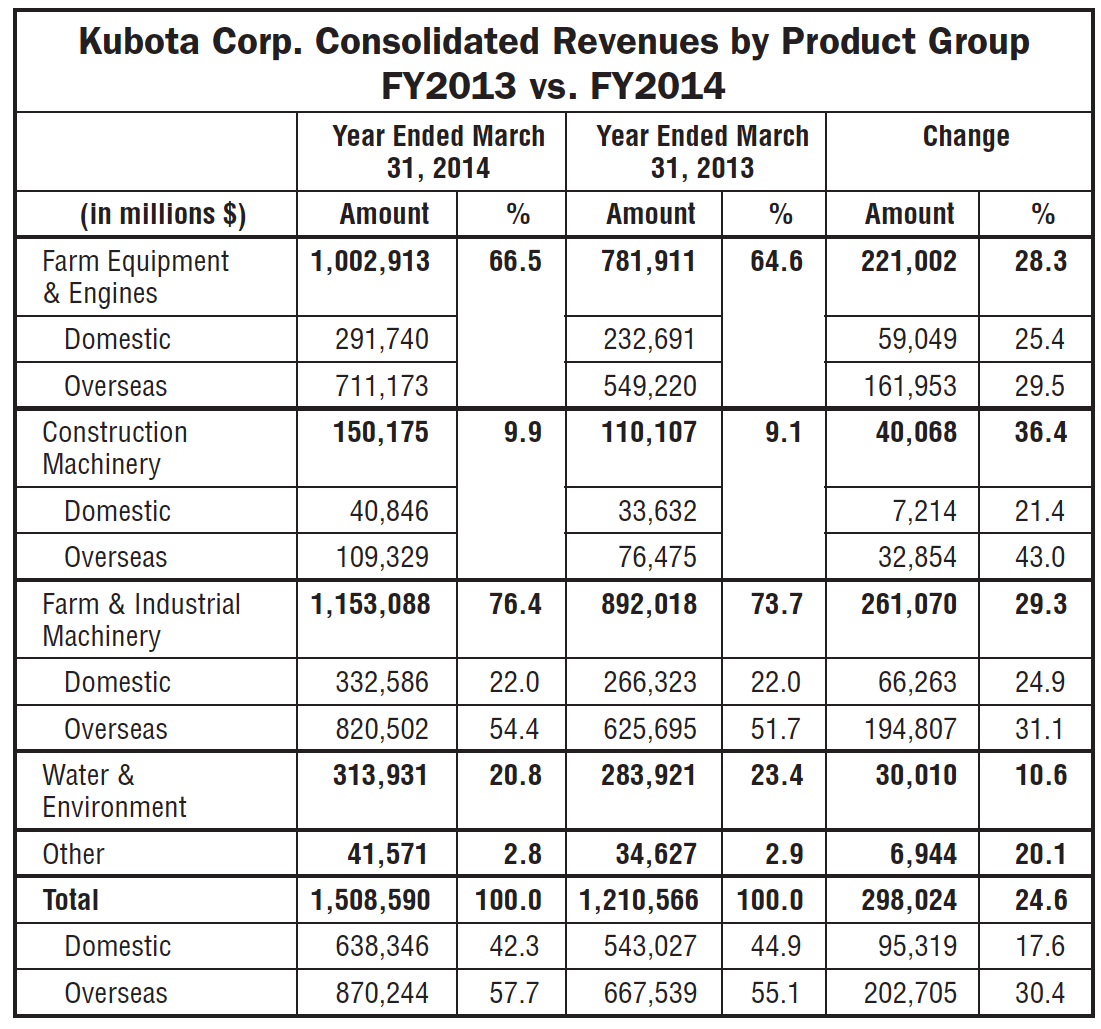Strong overseas sales of farm machinery, engines and construction equipment helped Kubota Corp. increase its consolidated revenues by 24.6% for its fiscal year ended March 31, 2014. The Japanese manufacturer of farm and industrial machinery, including engines and construction equipment, water and environmental products, and construction services, reported its revenues increased $2.9 billion to $14.9 billion from the prior year.
Despite the untimely death of Yasuo Masumoto, Kubota’s chairman and president, on June 4, in its earnings report the company, best known for its small and mid-size tractors, said it would continue with Masumoto’s initiative of aggressively expanding its business into large farm equipment.
For the fiscal year, revenues from farm equipment and engines accounted for 66.5% of total revenues, up from 64.6% in the previous year, while construction machinery contributed 9.9%, up from 9.1% in fiscal year 2013. Of the 76.4% of revenues attributed to farm and industrial machinery, 54.4% resulted from sales to overseas markets.

In the company’s domestic market, revenues increased $940 million (17.6%), to $6.3 billion, from the prior year. In overseas markets, revenues increased $2 billion (30.4%), to $8.6 billion, from the prior year. Overseas revenues in Farm & Industrial Machinery rose in North America, Asia outside Japan and Europe. The ratio of overseas revenues to consolidated revenues was 57.7%, 2.6 percentage points higher than in the prior year.
Operating income increased $800 million (66.8%) from the prior year, to $1.99 billion, due to increased domestic and overseas revenues and the effect of yen depreciation. Net income attributable to Kubota Corp. was $1.3 billion, $528.99 million (68.7%) higher than in the prior year Farm & Industrial Machinery. Revenues from Kubota’s Farm & Industrial Machinery segment, which is comprised of ag equipment, engines and construction machinery, increased 29.3% from the prior year to $11.4 billion, and accounted for 76.4% of consolidated revenues.
Domestic revenues in this segment increased 24.9% to $3.3 billion and were fueled by record sales of farm equipment. Overseas revenues increased 31.1%, to $8 billion. For the North American region, Kubota said, “Sales of tractors increased favorably due to the effects of launching a new line of products and other factors.” Operating income in this segment increased 69.2% to $1.9 billion.
2015 Outlook
Kubota expects its overall revenues to rise by 2.7% to $15.3 billion during its next fiscal year ending March 31, 2015. For its farm and industrial machinery operations, the company had only a slight upturn of 0.6% for the year, to $11.4 billion, largely due to a 12.8% drop in domestic sales. It is projecting its overseas business in the farm and industrial machinery segment to increase by 6% to $8.6 billion.
Strategic Plans
Kubota said it is “accelerating the development of its large scale agricultural machinery for dry-field cultivation. Thus far, the company has expanded its overseas business activities by building on the base it has developed in Japan in the agricultural machinery for rice paddy cultivation.

To realize growth in the medium-to-long-term, the company will dramatically expand its agricultural machinery business by making a full-scale entry into the market for dry-field cultivation, where the area under cultivation is estimated to be more than four times larger than the rice cultivation market.”
Following Kubota’s acquisition of European-based implement manufacturer Kverneland for dry-field cultivation in 2012, it “made the decision in December 2013 to establish a manufacturing plant for dry-field cultivation machinery in Europe, and is thus taking its first step toward becoming a comprehensive manufacturer of agricultural machinery,” the company said.
Kubota also indicated that it will accelerate the development of its business by expanding its lineup of products “at an early date, strengthening and expanding its sales and service network with the aim of building a strong position in the market for dry-field cultivation machinery, and implementing other measures to rank alongside existing European and U.S. manufacturers in this field.”
As it has made clear earlier (see Ag Equipment Intelligence, December 2013) Kubota said it “will consider a range of options, including alliances with other companies.”






Post a comment
Report Abusive Comment